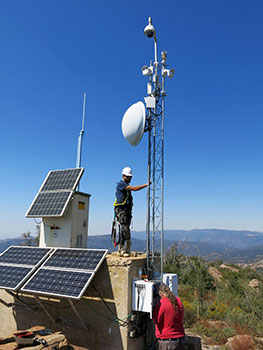Augmented camera capabilities created by collaboration between multiple universities and private industry in support of fire watch activities
HPWREN, in collaboration with San Diego Gas and Electric (SDG&E), as well as the University of Nevada Reno (UNR), has begun to add cameras with optical zoom capability to its vast network of environment-observing cameras.
HPWREN began to experiment with pan-tilt-zoom cameras as far back as 2001. An initial operational deployment was on Mount Laguna in 2002 (/news/020924.html), with the objective then being to research weather impacts on HPWREN's wireless links. However, fixed cameras quickly became the favorite instead back then, when in a side-by-side comparison CDF (now Cal Fire) firefighters at their San Diego Emergency Command Center expressed preference for the higher resolution and predictable view of the non-movable cameras, which then over the years grew into many multi-camera 360 degree fixed view systems, most of them having dual-imagers for visible light and monochrome/near-infrared. Fire plumes often evolve into dominating the images of even a 90 degree view camera, and the previous PTZ cameras were typically zoomed out anyway during such events. While the fixed cameras are capable of fast frame rates, for practical reasons the images have been collected at a once-per-minute rate for many years, including to contain network bandwidth use and disk space requirements for long term storage. However, much faster frame rates have been used for specific events, and more recently to stream real-time fire animations live to Youtube for public viewing.
Recent changes include a much higher image quality at 6 megapixel resolution, and the regular availability of full resolution videos for the eight 3-hour intervals per day, at a temporal resolution of a frame per minute. Additionally, access to self updating large images is now supported at the once per minute rate. Furthermore the image servers have been transitioned to a more modern and faster platform.
A limit of the current system was the inability to effectively zoom in to small fires, especially when one is far from existing cameras, which is where a new project with SDG&E and UNR comes in. This project has been supplementing the existing system with High-Definition 2-megapixel cameras, capable of zooming to smaller events, such as fires and flooding, or details of larger ones. Having both capabilities of a constant high resolution surround view, alongside the ability to zoom into the detail of a scene, is a substantial evolutionary step.
Future opportunities to advance an agenda of cyberinfrastructure-enabled environmental sensors include thermal or even hyper-spectral cameras, as well as varieties of other sensors (such as air quality or soil moisture or fuel moisture), deployable on mountain tops, or at HPWREN access sites.
http://sdgenews.com/safe/new-alert-sdge-cameras-prove-be-critical-fire-watch-tool-region
/cameras/ptz.html, with /cameras/u/ptz.html supporting real-time once-per-minute updates for large images.
